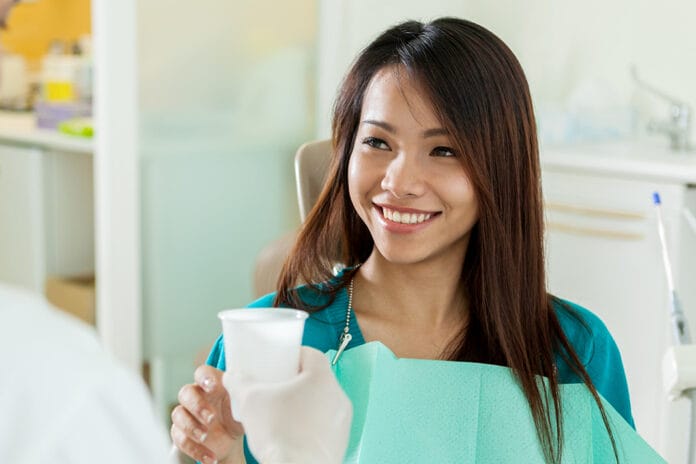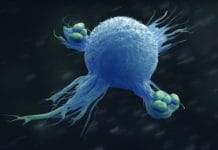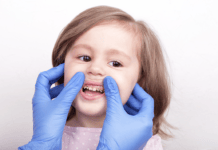Hygiene schools teach the importance of preprocedural rinses (PPMR), viewing it as a method for lowering the bacterial load and preventing the spread of disease/microorganisms. When the pandemic descended upon us, the American Dental Association (ADA) and the American Dental Hygienists’ Association (ADHA) once again pushed the narrative that preprocedural rinses, specifically hydrogen peroxide, were necessary and beneficial to reduce the spread of SARS-CoV-2.
However, what evidence did they rely on when making these assertions? Is preprocedural rinsing all it is hyped up to be regarding reducing the spread of SARS-CoV-2?
According to the Centers for Disease Control and Prevention (CDC), “There is no published evidence regarding the clinical effectiveness of PPMRs to reduce SARS-CoV-2 viral loads or to prevent transmission. Although SARS-CoV-2 was not studied, PPMRs with an antimicrobial product (chlorhexidine gluconate, essential oils, povidone-iodine, or cetylpyridinium chloride) may reduce the level of oral microorganisms in aerosols and spatter generated during dental procedures.”1
The CDC did not mention hydrogen peroxide as a possible effective PPMR. I was curious where and why the ADA and ADHA took the stance that hydrogen peroxide was the rinse of choice. The ADA and ADHA released their guidelines for dental settings prior to the CDC statement, which led many hygienists and dentists to implement hydrogen peroxide as the rinse of choice. This is blatant misinformation, and I was seriously disappointed to see this recommendation in the absence of evidence.
To be fair, the ADHA has revised its guidance to align with the CDC. However, the ADA still lists 1% hydrogen peroxide as the PPMR of choice.2,3 Unfortunately, until this pandemic, there were no studies evaluating the efficacy of PPMRs on viral load. The focus has always been on lowering the bacterial load prior to aerosolizing procedures.
Delving into Related Studies
Some suggest that the recommendation for the use of hydrogen peroxide as a PPMR was based on a study by Kampf et al. (2020). However, this study was evaluating the efficacy of Accelerated Hydrogen Peroxide, which has additional ingredients in addition to hydrogen peroxide. Moreover, the results were limited to inanimate surfaces, which don’t apply to the oral cavity. So, these results cannot be extrapolated to the oral environment.4
Furthermore, in an in vitro study, hydrogen peroxide in concentrations of 1.5% and 3% were evaluated for efficacy against SARS-CoV-2 with a contact time of 30 seconds. The results showed little effect as a viricidal agent. The authors attribute this to the presence of host and bacteria-derived catalase activity in saliva.5
In another prospective clinical pilot study evaluating the efficacy of 1% hydrogen peroxide on intraoral viral load of SARS-CoV-2, the authors found “1% hydrogen peroxide mouth rinse does not reduce the intraoral viral load in SARS-CoV-2-positive subjects. However, virus culture did not yield any indication on the effects of the mouth rinse on the infectivity of the detected RNA copies.” These results leave questions about the infectivity of the RNA detected in the saliva.7
False Sense of Security?
I’m not suggesting we stop using PPMRs. However, I suggest that clinicians not get a false sense of security by using PPMRs. There is currently a clinical trial in the form of a randomized controlled trial evaluating the effect of essential oils, hydrogen peroxide, cetylpyridinium chloride, and chlorine dioxide solutions in the reduction of viral load in saliva. As it stands, the trial has not yet started recruiting. Consequently, we will not have the results for some time.
The pandemic has brought many learning experiences and new studies regarding aerosols produced in the dental setting. This has long been a neglected area of research in dentistry. The pandemic has brought many negatives, but maybe we will get a few positives from it. If PPMRs can reduce the viral load of SARS-CoV-2, it may also be beneficial in reducing the viral load of other respiratory viruses.
Another issue with PPMRs as it applies to SARS-CoV-2 that concerns me is that if it effectively reduces the viral load, how long does the efficacy last? We must consider SARS-CoV-2 is a respiratory virus with high viral loads in the nasopharyngeal tract as well as saliva. Though the length of time it takes for the virus to replicate if neutralized in the mouth and throat is unknown, other similar viruses are secreted constantly. If we extrapolate this replication cycle to SARS-CoV-2, you may have a window of around 60 seconds before the viral load is back to its original state prior to rinsing.8
I don’t want to discount the benefits of PPMRs in reducing the bacterial load prior to aerosolizing procedures. This is the very reason we are taught to have patients rinse prior to their appointments. However, I’m very disappointed that the ADA recommended and is still recommending a mouth rinse with no evidence to support the efficacy in reducing viral load associated with SARS-CoV-2. I understand the need to cover all our bases during the pandemic but having such a recommendation without any caveat to express the lack of evidence is a form of misinformation/disinformation, which can, in some cases, be dangerous.
In conclusion, my main goal is to ensure hygienists are informed and aware of all risks associated with their job. I have no idea if 1% hydrogen peroxide is an effective PPMR, nor does the ADA because there is a lack of studies to show efficacy. If your office has implemented hydrogen peroxide as a PPMR, please be aware of the lack of evidence to support it, and don’t let your guard down. Stay diligent and safe. Hopefully, we are closer to the end of the pandemic than the beginning.
Need CE? Check Out the Self-Study CE Courses from Today’s RDH!
Listen to the Today’s RDH Dental Hygiene Podcast Below:
References
- COVID 19. Guidance for Dental Settings. (2020, December 4). Centers for Disease Control and Prevention. Retrieved from https://www.cdc.gov/coronavirus/2019-ncov/hcp/dental-settings.html
- ADHS Interim Guidance on Returning to Work. (2020, August 5). American Dental Hygienists’ Association. Retrieved from https://www.adha.org/resources-docs/ADHA_TaskForceReport.pdf
- Versaci, M.B. (2020, March 12). ADA adds frequently asked questions from dentists to coronavirus resources. American Dental Association. ADA News. Retrieved from https://www.ada.org/en/publications/ada-news/2020-archive/march/ada-adds-frequently-asked-questions-from-dentists-to-coronavirus-resources
- Kampf, G., Todt, D., Pfaender, S., Steinmann, E. Persistence of coronaviruses on inanimate surfaces and their inactivation with biocidal agents. J Hosp Infect. 2020; 104(3): 246–251. doi: 10.1016/j.jhin.2020.01.022.Retrieved from https://pubmed.ncbi.nlm.nih.gov/32035997/
- Reis, I.N.R., do Amaral, G.C.L.S., Mendoza, A.A.H., et al. Can preprocedural mouth rinses reduce SARS-CoV-2 load in dental aerosols?Med Hypotheses. 2021; 146: 110436. doi:10.1016/j.mehy.2020.110436. Retrieved from https://www.ncbi.nlm.nih.gov/pmc/articles/PMC7691843/
- Anteseptic Mouthwash/Pre-Procedural Rinse on SARS-CoV-2 Load (COVID-19) (AMPoL). (2020, November 20). US National Library of Medicine. Retrieved from https://clinicaltrials.gov/ct2/show/NCT04409873
- Gottsauner, M.J., Michaelides, I., Schmidt, B., et al. A prospective clinical pilot study on the effects of a hydrogen peroxide mouthrinse on the intraoral viral load of SARS-CoV-2. Clin Oral Investig. 2020 Oct; 24(10): 3707-3713. doi: 10.1007/s00784-020-03549-1. Epub 2020 Sep 2. PMID: 32876748; PMCID: PMC7464055. Retrieved from https://link.springer.com/article/10.1007/s00784-020-03549-1
- O’Donnell, V.B., Thomas, D., Stanton, R., et al. Potential Role of Oral Rinses Targeting the Viral Lipid Envelope in SARS-CoV-2 Infection. Function (Oxf). 2020; 1(1): zqaa002. doi: 10.1093/function/zqaa002. Epub 2020 Jun 5. PMID: 33215159; PMCID: PMC7239187. Retrieved from https://academic.oup.com/function/article/1/1/zqaa002/5836301












